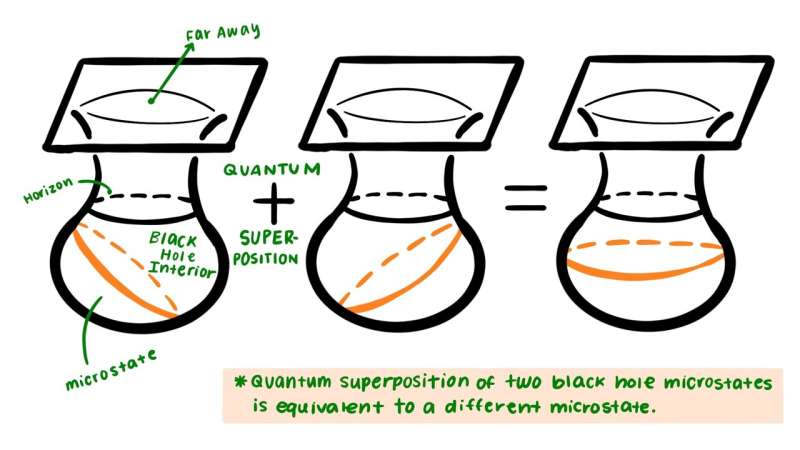May 20, 2024 feature
This article has been reviewed according to Science X's editorial process and policies. Editors have highlighted the following attributes while ensuring the content's credibility:
fact-checked
peer-reviewed publication
trusted source
proofread
A model outlining the microscopic origin of black hole entropy

Black holes are intriguing astronomical objects that have a gravitational pull so strong that it prevents any object and even light from escaping. While black holes have been the topic of numerous astrophysical studies, their origins and underlying physics remain largely a mystery.
Researchers at the University of Pennsylvania and the Centro Atómico Bariloche recently introduced a new model of black hole microstates regarding the origin of entropy (i.e., the degree of disorder) in black holes.
This model, presented in a paper published in Physical Review Letters, provides an alternative perspective on black holes that could inform future astrophysics research.
"The Bekenstein-Hawking entropy formula, which describes the thermodynamics of black holes, was discovered in the 1970s," Vijay Balasubramanian, co-author of the paper, told Phys.org. "This formula suggests that black holes have an entropy proportional to the area of their horizons.
"According to statistical physics, as developed by Boltzmann and Gibbs in the late 19th century, the entropy of a system is related to the number of microscopic configurations that have the same macroscopic description.
"In a quantum mechanical world like ours, entropy arises from the quantum superpositions of 'microstates,' that is, microscopic constituents that yield the same observable traits at large scales."
Physicists have been trying to provide a credible account of black hole entropy for decades. In the 1990s, Andrew Strominger and Cumrun Vafa leveraged a hypothetical property known as "supersymmetry" to devise a method to count the microstates of a special class of black holes for which mass equals the electromagnetic charge, in universes with extra dimensions and multiple kinds of electric and magnetic fields.
To explain the origin of entropy of black holes in universes like ours, Balasubramanian and his colleagues had to create a new theoretical framework.
"Despite previous attempts, there has so far been no account that applies to the sorts of black holes that form from stellar collapse in our world," Balasubramanian said. "Our goal was to provide such an account."
The primary contribution of this recent work was to introduce the new model of black hole microstates, which can be described in terms of collapsing dust shells inside the black hole. In addition, the researchers devised a technique to count the ways of superposing these microstates quantum mechanically.
"The key insight of our work is that very different spacetime geometries corresponding to apparently distinct microstates can mix with each other because of the subtle effects of quantum mechanical 'wormholes' that link distant regions of space," Balasubramanian said.
"After accounting for the effects of these wormholes, our results showed that for any universe containing gravity and matter, a black hole's entropy is directly proportional to the area of its event horizon, as Bekenstein and Hawking proposed."
The recent work by Balasubramanian and his colleagues introduces a new way of thinking about black hole microstates. Their model specifically describes them as quantum superpositions of simple objects that are well-described by classical physical theories of matter and spacetime geometry.
"This is very surprising, because the community had expected that a microscopic explanation of the entropy of black holes would require the full apparatus of a quantum theory of gravity, such as string theory," Balasubramanian said.
"We also show that universes that differ from each other at macroscopic, even cosmic, scales can sometimes be understood as quantum superpositions of other, macroscopically different universes. This is a manifestation of quantum mechanics at the scale of the entire universe, which is surprising given that we typically associate quantum mechanics to small scale phenomena."
The newly introduced theoretical framework could pave the way for other theoretical work aimed at explaining the thermodynamics of black holes. Meanwhile, the researchers plan to expand and enrich their description of black hole microstates.
"We are now studying to what extent, and in what circumstances, an observer outside the event horizon can determine which microstate a black hole is in," Balasubramanian added.
More information: Vijay Balasubramanian et al, Microscopic Origin of the Entropy of Astrophysical Black Holes, Physical Review Letters (2024). DOI: 10.1103/PhysRevLett.132.141501
Journal information: Physical Review Letters
© 2024 Science X Network




















